
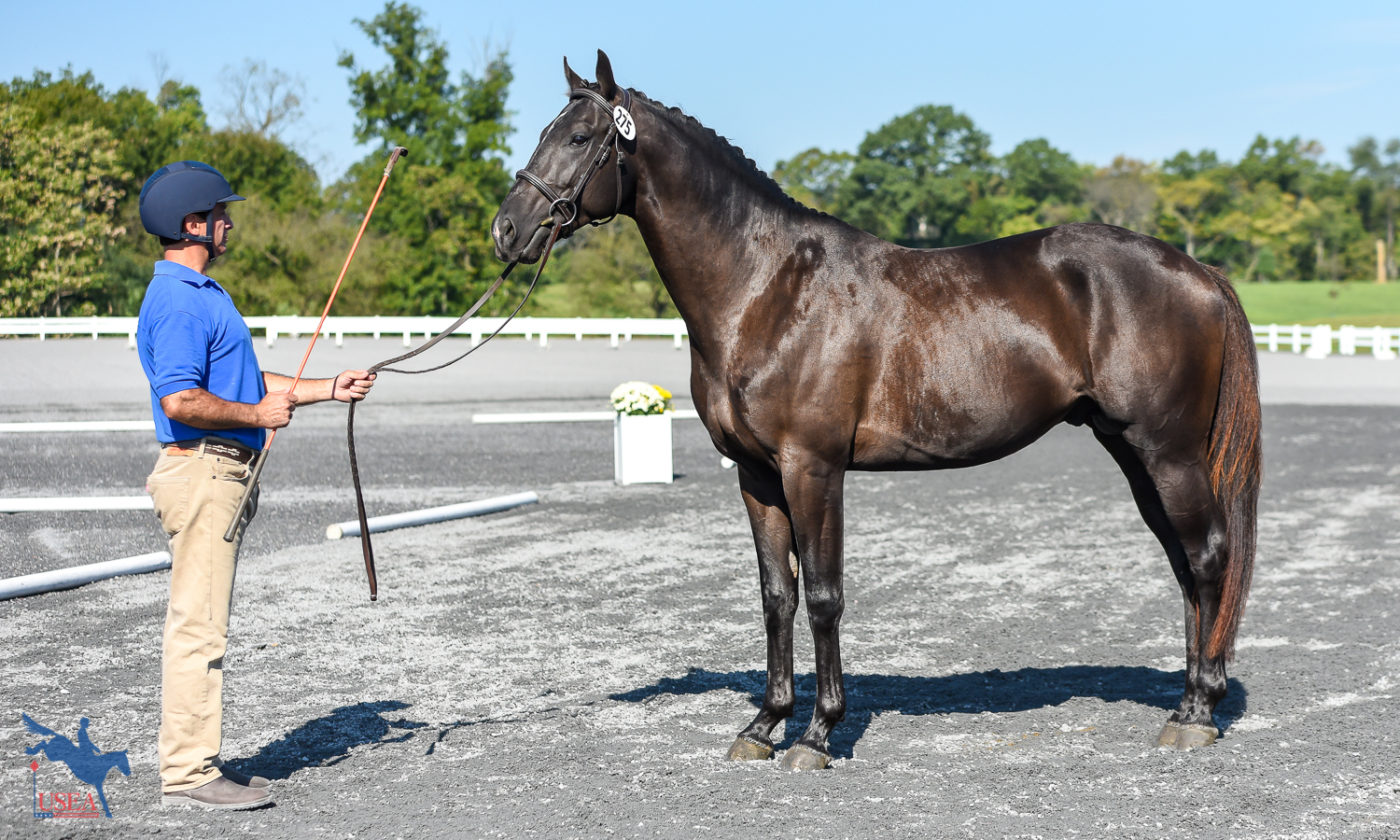
“It’s true that an ideal conformation is something to strive for, but most horses don’t have ideal conformation,” observed Dr. Norris Adams, Clinical Assistant Professor in Equine Lameness and Surgery at Virginia Tech's Marion duPont Scott Equine Medical Center (EMC) in Leesburg, Virginia. “We know that, if you have a fault or some sort of conformational defect, it’s not an unsoundness in itself but it is a weakness that predisposes a horse to lameness. It’s sort of like buying a car with one tire that’s half worn off.”
With over 25 years of experience performing lameness exams, Dr. Adams has seen a lot, from the minor conformational imperfections to the major structural defects and everything in between, and he knows how those conformation flaws will affect a horse’s soundness down the road. “That’s what we’re talking about with conformational defects – it’s a weakness and the horse is going to have a lameness predisposition that wouldn’t occur if that horse had good conformation.”
“You’re born with that conformation, so if we want to be an athlete we can train for it, we can get fit, we can eat well, we can worry about conditioning, but there’s not a lot we can do to change our conformation,” Adams continued. “If you have the chance to choose a horse, consider that, once you get it, you’re going to be stuck with it – the conformation – and it does have an impact on that horse’s performance.”
If conformation plays such a crucial role in a horse’s ability to perform, what are the best ways to evaluate it and what are the conformational weaknesses to watch out for?
“You don’t just look at a horse from a static view, and you don’t just look at them from one angle,” Adams stressed. “You’ve got to walk around them, you stand behind them, you stand to the side and the front, and then you have to watch them move. Some of these conformational defects will only show up when the horse is in motion.”
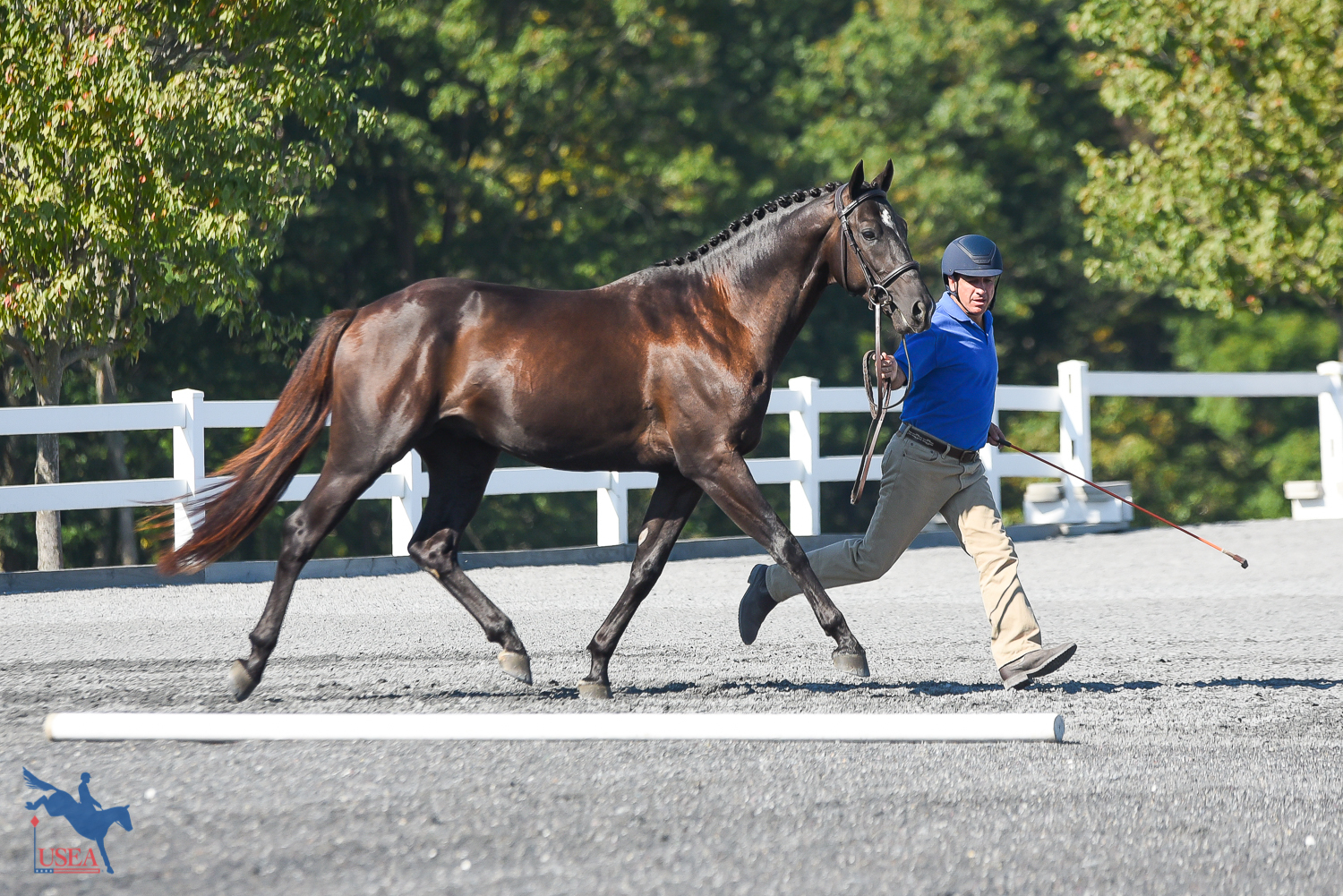
When Adams is investigating the cause of a lameness, he includes a conformational examination, but the majority of conformation exams that Adams has performed have been part of pre-purchase exams. “We’re trying to prognosticate – to look into the future and say, ‘How long is this horse going to stay sound?’ Conformation really plays a huge role in that equation, so you try to really pick them apart.”
“When a conformational defect does cause a lameness you’re in trouble because there’s nothing you can do to eliminate it. You can treat it, but it’s going to keep coming back. The more activity and the more intensity of that activity, the more likely it is to cause a problem.”
Adams emphasized that, when evaluating horses, you have to have an ideal in your mind to compare to – and that’s not necessarily going to be the same for everyone. An eventer, for example, will be looking for something different in a horse’s conformation than a pure show jumper or dressage rider. However, there are some general constants that all well-conformed horses will share. “You’re looking for a symmetrical, well-proportioned, balanced animal with a lot of muscle. He’s got a nice angulation to his pasterns and his shoulder, his legs are straight, and his has an attractive head and neck that counterbalance his body.”
As the front legs of the horse carries approximately 60% of his body weight, the conformation of the front load-bearing structures can make or break a horse’s soundness. “If you’re looking from the front, there should be a straight line coming down from the point of the shoulder. It should drop down, bisect the carpus all the way down through the pastern, and the hoof should be pointing straight forward. You want adequate breadth in the chest and straight legs. With a straight column, you can imagine that all the bones and joints are loaded straight down, there’s no stresses placed to one side or the other.”
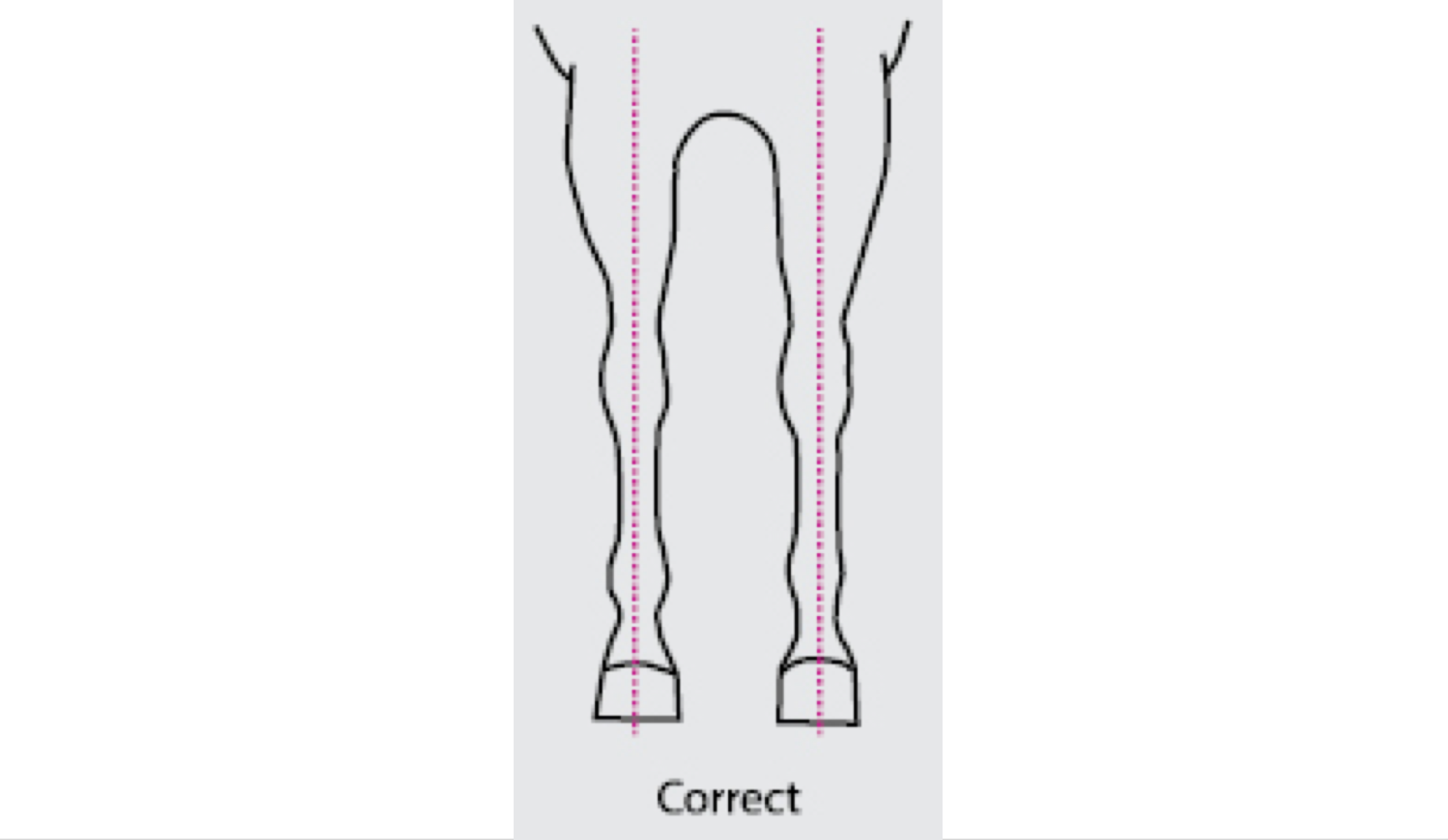
A bowlegged horse is one example of a deviation from ideal front leg conformation and presents as a wideset chest and legs that then bent inward as the leg extended down. “When you deviate from that ideal column and you have a bow, two things happen: the inside of the bow concentrates the downward concussive stresses and the outside of the bow takes all of the tension. The outside collateral ligaments are stressed every time the horse moves and the inside of the bone is being compressed.”
Conversely, a horse with very narrowly set legs will have difficulty balancing, especially when turning, because he lacks a base of support. “Turning and twisting is going to be extremely unstable and unathletic. You want a horse with an adequate breadth of chest. The horse isn’t going to limp, but it’s going to detract from athletic potential.” If that narrow chest results in narrow-set legs all the way down, the horse will likely interfere with himself as well.
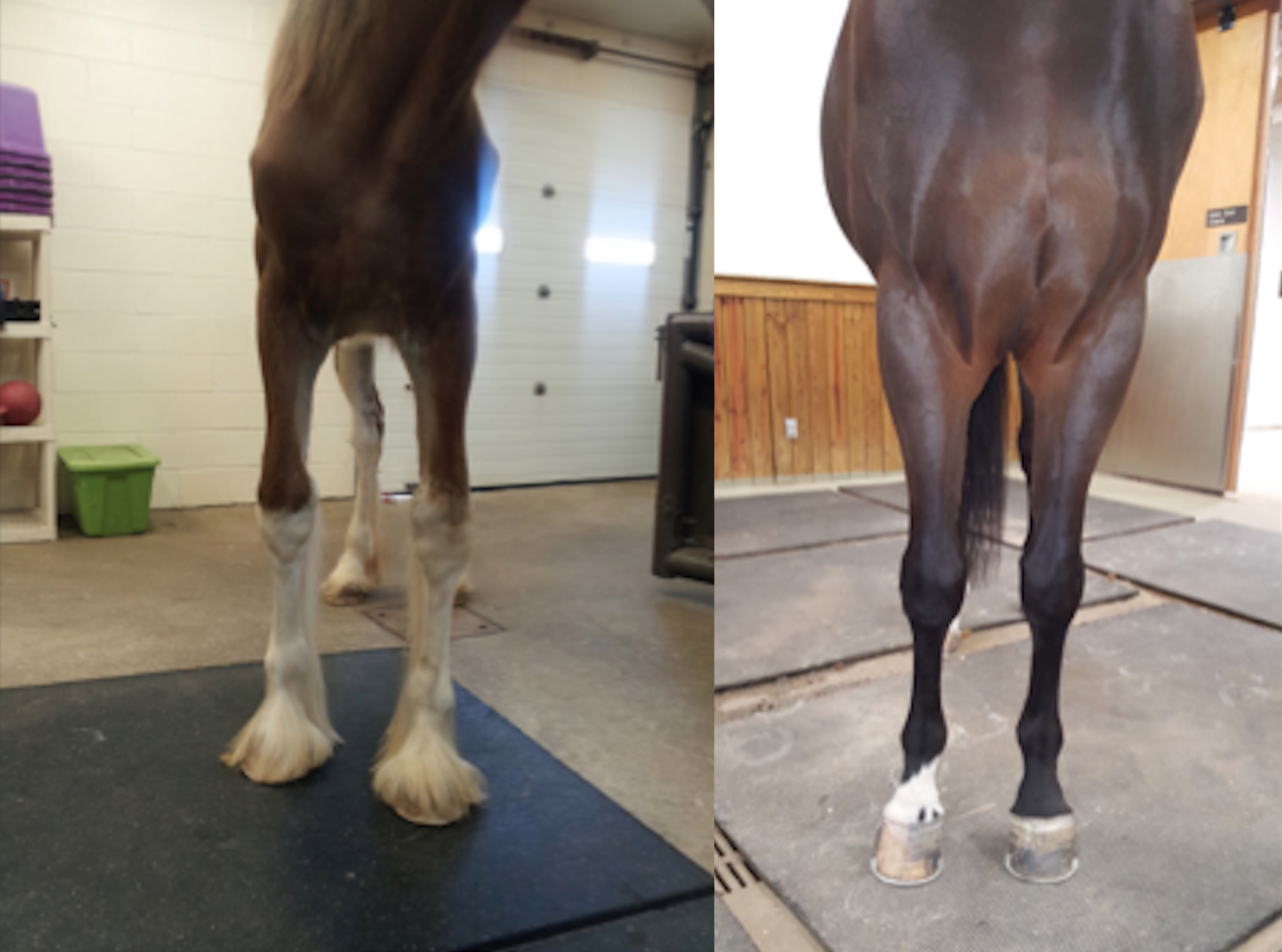
Rotation of the leg in results in a pigeon-toed horse, which is often correlated with a bowlegged conformation of the upper legs and chest. “You can see the stresses in the coffin joint, but when you watch this horse move it’s not going to be pleasant because he’s going to have a significant paddling action. Instead of tracking in a nice straight line they will wing out.”
Knock-kneed horses, or horses that toe out, will wing in, which can cause serious interference. “They’ll oftentimes hit themselves on the splint bone or sesamoid bone and he’ll have to wear some kind of protective boot to avoid trauma.”
A horse with legs set well at the shoulder but splaying outward at the base will run into trouble with the joints closest to the ground. “When you have a deviation where it has the greatest effect down near the ground, at the base of the “triangle,” that’s going to highlight in the hoof, the coffin joint, and maybe even in the pastern.”
An offset or “bench” knee is a relatively common occurrence that Adams sees where, instead of coming down in a straight line, the upper limb isn’t set straight over the lower limb, meaning the knee extends unevenly from one side to the other. “All the downward forces will be transferred to the inside [or outside] of the leg and it’s common for them to get these huge splint bones. The leg is trying to build up support where there is none – it’s building a buttress to try and support that weight.”
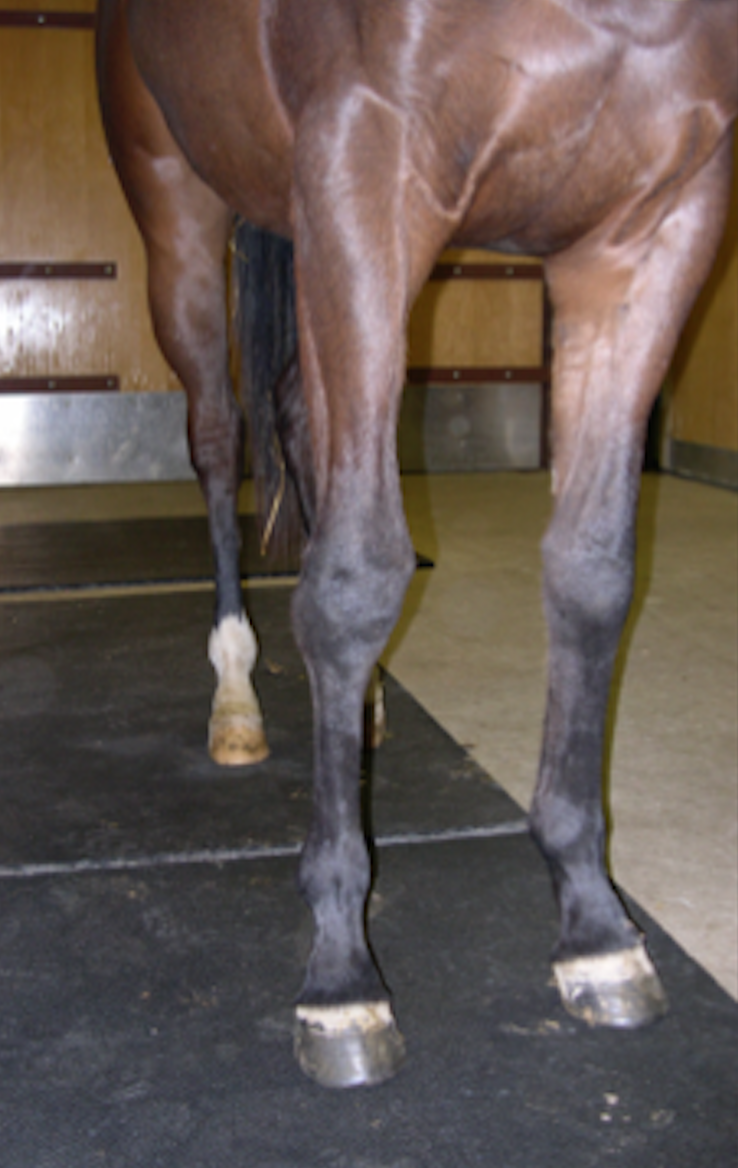
Looking at the front leg and shoulder conformation from the side, Adams points out that you want the angle of the shoulder and the angle of the pastern to match, ideally at around a 45-degree angle. Then, you want to see a straight line extend from the highest point of the withers straight down, bisecting the limb and ending at the bulb of the heel. “The straighter the limbs are, the more concussion the limb will absorb. The straighter [more upright] they are, the stiffer they are, and they have more bone stress as a result. The greater angulation to the shoulders and the pasterns will have more lift and elevation – a lot of elasticity and springiness – but as a result they will have soft tissue strains, that’s where the weakness is.”
A calf knee, or a knee that bows back, is a serious flaw that puts stress on the back of the knee, often resulting in tearing of the flexor tendons. “It puts severe stress on the soft tissue running down the back of the leg.” Conversely, horses who are over at the knee are very prone to stumbling.
A long pastern leaves horses prone to soft tissue injuries. “The longer the pastern in, the more likely you are to have injuries at the back of the cannon bone in the suspensory ligament or the flexor tendon. A horse with a long pastern may have a beautiful gait, but they are vulnerable.” In comparison, a horse with an upright pastern will take the brunt of the concussive force in his joints, leaving him susceptible to things like arthritis and ringbone.
Stay tuned to discover the ideal conformation of the hind legs, back, and feet, and what conformational pitfalls to be on the lookout for!
After receiving his DVM from Mississippi State University in 1992, Dr. Adams completed an internship at the Alamo Pintado Equine Medical Center in Los Olivos, California. He then entered private equine practice and spent a year in Saratoga Springs, New York, and a year in western Pennsylvania before completing a residency in large animal surgery at the University of Minnesota in 1998. He achieved Diplomate status through the American College of Veterinary Surgeons in 1999. Dr. Adams then worked in a horse show practice in Fairfield, Connecticut for one year before serving a two-year stint as a clinical instructor in large animal surgery at the Virginia-Maryland College of Veterinary Medicine in Blacksburg, Virginia, In 2001, Norris moved to Middleburg, Virginia, and was an associate veterinarian and surgeon at The Middleburg Equine Clinic for five years. Immediately prior to joining EMC as a clinical assistant professor in equine lameness and surgery, Dr. Adams worked as an associate veterinarian and surgeon at the Piedmont Equine Practice in The Plains, Virginia, from 2006 to January 2008. He achieved Diplomate status in the American College of Veterinary Sports Medicine and Rehabilitation in 2017. Dr. Adams' expertise includes lameness, imaging, and orthopedics.
The United States Eventing Association, Inc. (USEA) is thrilled to announce Canter Culture as a “Silver Sponsor for the USEA American Eventing Championships” taking place at the Kentucky Horse Park in Lexington, Kentucky, Aug. 27-Sept. 1.
If you’re a new team setting out to compete in the 2024 USEA Intercollegiate and Interscholastic Eventing Championships in just a couple of weeks, preparing for the “happiest horse trial” in the U.S. may seem a bit daunting. With five components to the Spirit Award contest that require creativity and cohesion between team members, there is a lot that goes into preparing and packing to leave for the event.
Are you following along with the action from home this weekend? Or maybe you're competing at an event and need information fast. Either way, we’ve got you covered! Check out the USEA’s Weekend Quick Links for links to information including the prize list, ride times, live scores, and more for all the events running this weekend.
Since the mid-’80s, lifelong horsewoman and professional artist Debra Sue Waters has devoted countless hours to the sport of eventing, and last year topped the rankings of the USEA Volunteer Incentive Program in Area V. Assisting behind the scenes at an event just comes naturally to the Millsap, Texas, resident.